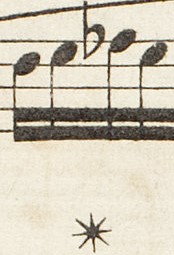



In A the pedal release in bars 63-68 is differentiated: in bars 63, 64 the  falls on the 2nd beat, bars 65-68 the
falls on the 2nd beat, bars 65-68 the  follows only after the 5th semiquaver from the end.
follows only after the 5th semiquaver from the end.
In GC in bars 63-66 the  falls on the 2nd beat (i.e. in bars 63 and 64 in accordance with A, although there is a visible trace of correction - an erroneous
falls on the 2nd beat (i.e. in bars 63 and 64 in accordance with A, although there is a visible trace of correction - an erroneous  at the end of the bar), bar 67 is consistent with A, in bar 68 - there are no
at the end of the bar), bar 67 is consistent with A, in bar 68 - there are no  and
and  signs.
signs.
GE copies GC, homogenising bar 67 with the remaining ones (i.e. shifting  to the middle of the bar), in bar 68 no pedalling was copied.
to the middle of the bar), in bar 68 no pedalling was copied.
EE is compatible with A except for bar 65 -  moved to the 2nd beat, analogously to bars 63 and 64; in addition, in bars 61-65 the pedalling is written between the staves.
moved to the 2nd beat, analogously to bars 63 and 64; in addition, in bars 61-65 the pedalling is written between the staves.
FE is more or less compatible with A – the hesitation is a result of an extremely compact notation in these bars (the 2nd beat in the R.H. does not fall exactly over the 2nd beat in the L.H.), therefore, it is hard to say with one hundred percent certainty whether  was written correctly or not, although the intention of A was certainly correctly understood.
was written correctly or not, although the intention of A was certainly correctly understood.
Compare the passage in the sources »
category imprint: Interpretations within context; Differences between sources
issues: Inaccuracies in FE, EE inaccuracies, Inaccuracies in GC
notation: Pedalling

 before a
before a in
in 